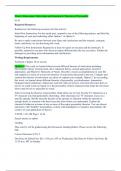Hofmann et al. (2014)
Hofmann et al (2014) presenteren een information retrieval systeem dat zijn resultaten kan
verbeteren door te leren van gebruikersinteracties. Door te leren van zulke interacties kan het
systeem een steeds betere ranking van de opgehaalde informatie bepalen. De data die wordt
gebruikt om een optimale ranking te leren bevat vaak veel ruis, wat het leren een stuk
ingewikkelder maakt. In dit artikel worden een aantal oplossingen gepresenteerd om ondanks de
ruis in de data toch efficient te kunnen leren:
• Welke nieuwe methoden dragen Hofmann et al (2014) aan?
• Waarom verbeteren deze methoden het leren van een optimale ranking functie?
- reasons learning directly from user interaction is difficult:
1. they are hard to interpret as feedback for learning because they are biased and noisy
2. the system can only observe feedback on actions shown to users → exploration/exploitation
3. amount of feedback & quality of learning is limited by the number of user interactions, so its
important to use the observed data as effectively as possible
- information retrieval (IR) systems provide easy access to constantly growing source of info
→ the user submits a query, receives a ranked list of results, and follows the best one
- making a result ranking as useful as possible depends on context (users age, location, etc)
- self-learning search engines: learn directly from natural interactions with their users online
→ can adapt and improve their rankings to the setting they are deployed in
- search interactions are noisy indicators that may correlate with preferences (dont reflect them)
→ are affected by how results are presented → influence which results are clicked, what makes
distinguishing the effects of true ranking quality hard
- solutions, focusing on evaluation and learning of ranking functions for IR:
1. an interleaved comparison method that allows unbiased and fine-grained ranker comparison
using noisy click data and that allows reuse of such data for new comparisons
2. an approach for modeling and compensating for click bias in user interactions with a web
search engine
3. an experimental framework that allows the assessment of online learning to rank methods for
IR using annotated data sets and clock models
4. learning approaches that improve the online performance of self-learning search engines by
balancing exploration and exploitation
5. methods for reducing the effects of click noise in learning to rank by reusing previously
observed interaction data










